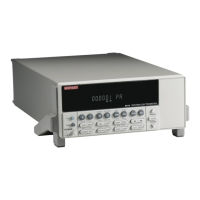Volts and Ohms Measurements 3-3
Input cable leakage and capacitance
In a similar manner to leakage in the test circuit, leakage in the input cable could also corrupt
high-impedance measurements. In the unguarded mode, leakage in a triax cable occurs between
the center conductor (HI) and the inner shield (LO).
Inherently, an input cable has capacitance that is formed by the center conductor (HI), inner
shield (LO) and the insulator between them. For high-impedance measurements, the RC time
constant can significantly slow down measurement response.
To minimize the effects of cable leakage, and input capacitance, keep the input cable as short
as possible and use guard. With guard enabled, the same potential is applied to both the center
conductor and inner shield of the cable. This eliminates leakage current and capacitor charging/
discharging.
NOTE Detailed information on "Cable Leakage Resistance”, “Input Capacitance (Settling
Time)” and “Guarding Input Cables” is provided in “Volts and Ohms Measurement
Considerations” (located in this section).
HI
HI
LO
GRD
LO
COMMON
COMMON
GRD Disabled
GRD Enabled
6514
6514
Insulator
(one of two)
Insulator
(one of two)
RL1
RL1
RL2
Leakage Path
DUT
DUT
Metal Mounting Plate
Metal Mounting Plate
0V
A. Unguarded
B. Guarded
Figure 3-1
High-impedance
voltage measurements

